Intel banks on efficiency to crack smartphones

So Intel has finally entered the smartphone market. But will anyone buy Intel-based phones? And should you even care?
What with all the fabulous new handsets and tablets that appeared at Mobile World Congress 2012 recently, it's hard to get excited by what is ostensibly a pretty unremarkable second handset following up the Lenovo K800 we saw at CES 2012.
With just one CPU core and no single specification to really sex it up, the Intel Atom-powered Orange Santa Clara certainly looked like a tough sell next to the lush new handsets from Nokia, Sony, HTC and Samsung.
More to the point, if you're in the market for a new smartphone, why on earth would roll the dice on some weirdo handset powered by an unproven x86 processor?
As it happens, early benchmarks of the Intel Atom Medfield processor found inside the Orange Santa Clara show that that it's not only a pretty quick customer, but also in the right ballpark when it comes to performance per watt.
It's about the clockspeed or cores
However, the reality is that Medfield is merely a proof of concept for Intel. Intel has yet to pull out the big guns. To understand why, you need to forget about cores, clockspeeds and the whole ARM vs x86 thing. If Intel gets anywhere in the smartphone business it will be thanks to process technology.
That's because smaller transistors and better manufacturing nodes make for faster, more efficient chips. Architectures will only get you so far. In fact, you could say that's what Intel is really all about.
Sign up for breaking news, reviews, opinion, top tech deals, and more.
In other words, the chip architectures are all very nice, but Intel's real advantage is in chip manufacturing. Intel spends billions of dollars on the fabs that build its chips. Year after year, it develops and rolls out perhaps the most advanced chip manufacturing technology on the planet. It's simply the best at this stuff.
That's in stark contrast to makers of the ARM chips who either pay someone else to knock out chips for them or treat chip manufacture as more of a bulk process than a fine art.
Smaller and smaller
Right now, Intel is tackling the transition from 32nm to 22nm. The first 22nm PC processors are due later this year. Currently, Intel is taking a pretty conservative approach to pushing its Atom chips onto new processes. Medfield is a 32nm processor. We won't see 22nm Atoms until next year.
But thereafter, Intel says it will schedule Atom for the earliest possible transition to new architectures. So we'll see both PC processors and phone chips on the 14nm process in 2014. And it's then that we'll really know just how much damage Intel can do to the big boys in phone chips.
If it stays on schedule and if its 14nm process delivers Intel traditional technology advantages, those 14nm phone chips could be killers. They should be the smallest, most efficient chips available. Not because they're x86. But because they'll be manufactured on a superior silicon process.
Twisting ARMs
Whether this actually happens or not, however, is another matter. Medfield probably already has a small process advantage at 32nm over most smartphone chips. Most current ARM chips for phones are either 40nm or 45nm, with a few 32nm efforts just appearing.
However, Intel recently announced a delay rolling out its first 22nm PC processors, so all isn't completely kosher with its 22nm node. Whether that will have any impact on 22nm Atoms next year and 14nm Atoms in 2014 is a pretty tough call.
As for whether you should care about any of this, well, if Intel does pull it off, that means more competition. And more competition will translate into faster, cheaper and longer lasting phones. I think we can all agree, that's a good thing.
Technology and cars. Increasingly the twain shall meet. Which is handy, because Jeremy (Twitter) is addicted to both. Long-time tech journalist, former editor of iCar magazine and incumbent car guru for T3 magazine, Jeremy reckons in-car technology is about to go thermonuclear. No, not exploding cars. That would be silly. And dangerous. But rather an explosive period of unprecedented innovation. Enjoy the ride.